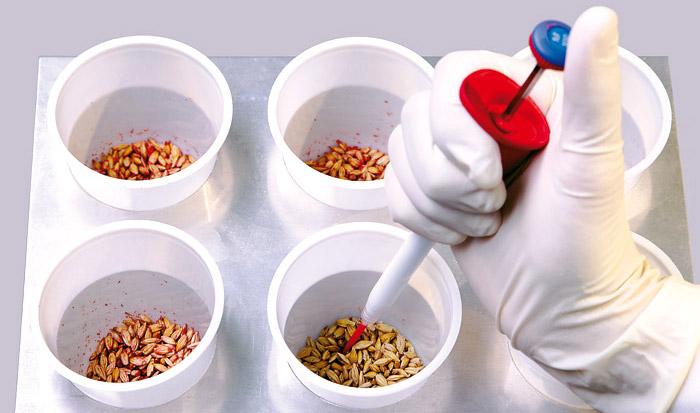Agriculture is the backbone of any nation's economy and food security. To meet the growing demand of the burgeoning global population, farmers need to maximize crop yields through innovative practices. One such practice that is gaining popularity worldwide is seed treatment. In this article, we will explore how seed treatment works and the various benefits it provides to farmers.
What is Seed Treatment?
Seed treatment refers to applying plant protection products like fungicides, insecticides and fertilizers directly to seeds before sowing. The active ingredients on the seed coat protect the germinating seed and growing seedling from damage caused by soil-borne diseases, insects and other pests. Seed treatment delivers just the right amount of product where it is needed - on and around the seed. This reduces waste and minimizes the environmental impact of agricultural chemicals.
Types of Seed Treatment
There are broadly two types of seed treatment products available in the market:
- Protectant Seed Treatment: These products contain fungicides, insecticides or inoculants that coat the seed surface, creating a protective barrier around the seed and young seedling. Examples include fungicides that prevent seed and seedling rot caused by soil fungi.
- Systemic Seed Treatments: Unlike protectant treatments, systemic products are absorbed into the seed tissues. As the seed germinates and the seedling grows, the active ingredients are translocated within the plant tissues and cells, providing longer-lasting protection. Neonicotinoid insecticides that controls sucking insect pests through the plant's vascular system are a good example.
Main Benefits of Seed Treatment
The benefits of seed treatment to farmers can be summarized as follows:
Early Season Protection: Seed treatment products provide crucial protection during seed germination and early seedling growth stage when plants are most vulnerable to insect and disease attack. This early protection ensures good crop establishment.
Higher Yields: Studies have shown that seed treatment can increase crop yields by 3-5% on average compared to untreated seeds. This translates to millions of dollars in additional income for farmers. Proper establishment leads to more plants per acre and greater harvest.
Cost-Effective: Seed treatment costs a fraction of other planting methods that require multiple foliar spray applications in the field. It delivers pest control precisely where and when the crop needs it at a very low usage rate.
Uniform Stands: Treated seeds lead to more uniform plant stands as seeds are protected against insect feeding and disease infection that causes poor and uneven germination. Uniform stands mature uniformly as well.
Convenience: Seed treatment products are usually formulated to require no mixing or complex calibration before application which is applied commercially at seed treatment facilities. This saves time during busy planting season.
CommonSeed Treatment Applications
Here are some of the most common agricultural crops and the typical seed treatment applications used:
- Cereals (wheat, rice, corn etc): Treatments against seed-borne diseases like loose smut, covered smut or seed rot caused by soil fungi. Also treatments against early season insect pests.
- Oilseeds (soybeans, canola, peanuts etc): Besides disease protection, treatments include insecticides for protection against seed and seedling feeding insects.
- Vegetables: Fungicide seed treatments to control diseases like damping off during germination. Some vegetables also receive insecticide treatments.
- Cotton: Apart from diseases, cotton seeds are routinely treated with insect growth regulators and neonicotinoids to control early season sucking pests like thrips.
- Pulses: Seed treatments against diseases like seed born blights and rots along with insecticide applications to guard against insect damage.
The Future of Seed Treatment Technology
With growing emphasis on sustainability and reduction of chemical usage, seed treatment technology is advancing towards more targeted and environment-friendly solutions. Some ongoing research areas include:
- Biopesticides: Development of biological agents as seed treatments made from naturally occurring substances like plant extracts and microbes instead of synthetic chemicals.
- Microencapsulation: Encapsulating active ingredients within tiny polymer capsules that safely deliver pesticides only when and where needed to further minimize soil and water contamination.
- Gene Editing: Using modern biotechnology tools to develop seeds with in-built genetic traits for pest and disease resistance so that dependence on chemical treatments is reduced over time.
- Nanotechnology: Use of nanoparticles as carriers for nutrients, signaling molecules and other actives for precision delivery, prolonged seed protection and maximized yields.
Seed treatment is a prudent agricultural practice that offers multiple farm income and environmental benefits. Combined with other modern cultivation techniques, it helps resource-strapped farmers to boost productivity and ensure food security. Ongoing innovations will make seed treatment methods even safer and sustainable to fully realize their potential in maintaining crop health globally.
For more details on the report, Read- Seed Treatment
